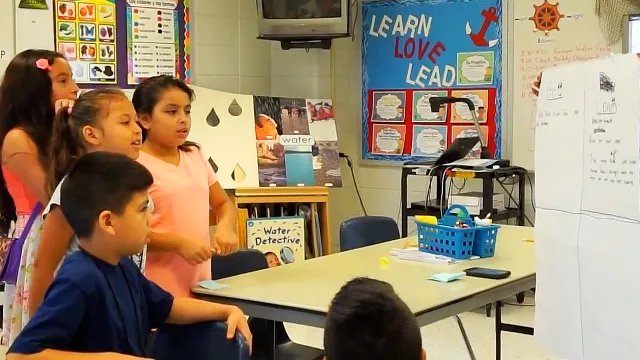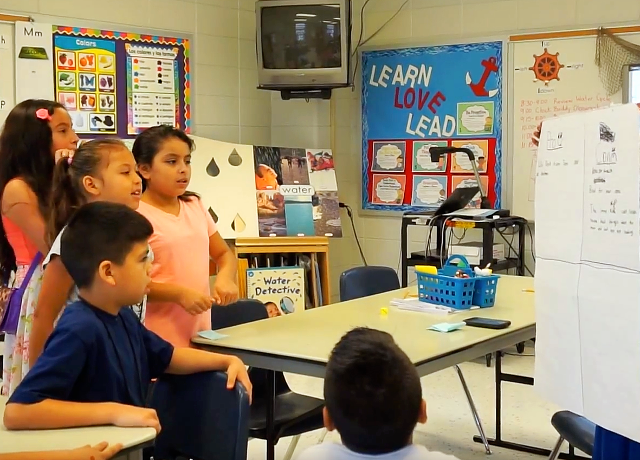Lessons Learned: How to Clarify Input for English Learners


Lessons Learned: How to Clarify Input for English Learners
They had been filling out their worksheets for 30 minutes, but I knew I wasn’t getting through to them. I could see their eyes glazing over, their heads starting to nod, and some of them even playing with their pencils.
“OK.” I thought. “I need to get this lesson to stick, and I know how I’m going to do it.”
I stood up a little straighter and smiled at the 30 eight-year-olds sitting in front of me, 85 percent of whom were designated ELs. I dove headfirst into a rousing speech about rounding. At the end of my enthusiastic monologue (about an admittedly uninspiring topic), I looked at all of them expectantly.
“Well … does it make sense now?”
I saw their heads earnestly bobbing up and down. It was truly a job well done – until I realized it wasn’t.
I asked one of my third graders to explain the “why” behind the answer on the board. She tried her best, but came up short. I asked another student, and then another, only to face similar results. Then, a wave of realization smacked me in the face. These kids needed more from me if they were going to truly learn this concept. It turned out that their nodding was more an affirmation that they loved to please their teacher than an indication that they understood the conceptual foundations of rounding.
My “off-the-cuff” monologue, despite my best intentions, was not clearly organized, didn’t include purposeful language, and did not provide any supports for my diverse learners. My flashy worksheets were one-size-fits all, filled with text that was above many of their levels. Little about this lesson, and the input I was providing them, was clear to my students.
As they made their way out of the classroom, I silently promised my students that I would do better tomorrow. That night, I dug out some packets on language strategies that I'd received earlier in the year. I searched for ways to improve my content delivery, build background and provide more support for my ELLs.
The next day, when the class arrived, they were met with a color-coded anchor chart filled with visuals. Key vocabulary words and their definitions had been written on sentence strips, carefully pasted onto the board. Rather than just sitting and listening to me talk about rounding as a concept, my students did multiple think-pair-shares where they discussed how their families might use rounding to make life easier at places like the mall or the grocery store. Rather than asking them if they understood, I walked around and listened to how they were explaining to their partners, so I could address any misconceptions. I had learned about all these strategies earlier in that school year, and I was thrilled to see their impact when used all together. The changes to my lesson and language delivery that day better positioned all my students to meet the lesson objective, but I was especially pleased to see how my English Language Learners benefited.
When you’re a new teacher, it’s easy to deliver a lesson with the best intentions, ask your students if they “get it,” accept their nods as affirmation, and move on. Luckily, I found that it’s easier still to modify your lessons with thoughtful, research-backed ELL instructional strategies that go a long way.
After that wake-up call in my first year of teaching third grade math in San José, Calif., I started using ELL strategies on a daily basis. Every lesson included a visual support, like an anchor chart and vocabulary sentence strips. When I was purposeful about minimizing“teacher talk”, student talk time increased markedly. My carefully planned lessons held a great focus on delivering purposeful instruction, improving student listening, and making all reading meaningful. I also worked to understand my students’ individual needs and provide varied supports whenever possible. And, most importantly, my students were less anxious and more successful than ever.

Making a targeted effort to incorporate language instruction into my lessons was the most impactful teaching decision I ever made. I saw the difference in my students’ content performance almost immediately after equipping them with resources and supports to meet their English-development needs. This is why I am so thrilled to see the impact of instructional strategies in general education classrooms across the country. When I read through Ellevation’s Practices and Strategies, I see activities and resources that I would have loved to implement in my math classroom. After all, ALL teachers can be teachers of language. Ellevation provides a powerful opportunity for educators of every discipline to help their ELLs reach their highest aspirations.
Check out this webinar to learn more about clarifying input for ELLs in the classroom.